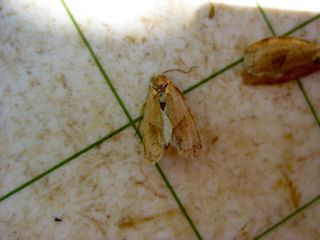Contents
-
Current degree day (DD) accumulations
- Orchard Radar insect synopsis
-
Upcoming meetings
The way I see it
- WANTED: Dogwood borers, Peachtree borers, Round- or Flat-headed Apple borers, or other boring insects.
- Special 'picture' edition Healthy Fruit
- Useful links
Current (through May 31) degree day
(DD) Accumulations
Location: UMass Cold Spring Orchard (CSO), Belchertown, MA
Base 43: 929
Base 50: 553
Significant upcoming orchard events based on degree days (Base 43):
Lesser appleworm 1st flight subsides: 990-1446
Codling moth 1st flight peak: 574-1008
Pear psylla 2nd brood nymphs hatch: 967-1185
Obliquebanded leafroller 1st flight peak: 843-1139
Peachtree borer 1st catch: 779-1347
Oriental fruit moth 1st flight subsides: 834-1120
Cherry fruit fly first catch: 755-1289
Spotted tentiform leafminer 2nd flight begins: 982-1152
Orchard Radar insect synopsis (for Belchertown)
http://pronewengland.org/AllModels/MAmodel/RADARMA-Belchertown.htm
- First dogwood borer egg hatch roughly: June 16. Peak hatch roughly: July 25
- Codling moth (CM) development as of June 2: 1st generation adult emergence at 73% and 1st generation egg hatch at 20%. In most orchards, insecticide targetted against plum curculio and apple maggot prevent codling moth damage. If targetted codling moth control is needed, key management dates are: 1st generation 3% CM egg hatch: May 26, Wednesday
(= target date for first spray where multiple sprays needed to control 1st generation CM); 1st generation 20% CM egg hatch: June 2, Wednesday (= target date where one spray needed to control 1st generation codling moth) - 1st generation Obliquebanded Leafroller (OBLR) flight begins around: May 28, Friday
- 2nd generation adult Spotted Tentiform Leafminer (STLM) begins around June 3, Thursday
Upcoming meetings
June 15, 16, 17: Tree fruit twilight meetings
Tuesday, June 15, Clark Brothers Orchards, 580 Apple Valley Rd., Ashfield,M, 5:30 PM
Wednesday, June 16, Parlee Farms, 95 Farwell Rd., Tyngsboro, MA, 5:30 PM
Thursday, June 17, Pippin Orchard, 751 Pippin Orchard Rd., Cranston, RI, 5:30 PM
July 15, 2010: Massachusetts Fruit Growers' Association Summer Meeting, UMass Cold Spring Orchard, Belchertown, MA
The way I see it
Last week's heat seems to have ramped up insect activity, although overall it's a pretty quiet time. Now is a good time to focus on any orchard activities such as young tree traininig that may have been overlooked during the previous busy few weeks. Otherwise, I hope you find this special 'picture' edition of HF interesting. JC
WANTED: Dogwood borers, Peachtree borers, Round- or Flat-headed Apple borers, or other boring insects.
We are doing biocontrol of Emerald Ash Borer (EAB), a beetle from China that has already killed 10’s of millions of ash trees in the Midwest and has spread to 13 states, including NY. We have already tested and released three parasitic wasps from China for biocontrol, but we will be getting a new parasitic wasp from Russia in a few weeks. We need to conduct safety tests to ensure that if we release this species it will only attack the EAB and not other native borers. To do that, we need to find and rear native borers. Would you please help us and give us a call if your orchard is infested with boring insects (we can collect either adults or mature larvae). We would be happy to take them off your hands and put them to good use. Please contact Tracy Ayer (ext. 248) or Juli Gould (ext. 220) at 508-563-9303 or send us an email at jennifer.ayer@aphis.usda.gov or juli.r.gould@aphis.usda.gov. Thank you in advance.
Juli Gould, Entomologist
USDA-APHIS-PPQ
Buzzards Bay, MA
Special 'picture' edition Healthy Fruit
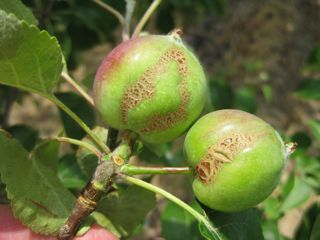 |
What is it? fost/freeze injury to Liberty apple What does it mean? likely occurred on or about May 10. Many orchards may see this on fruit, especially on low spots. The frost/freeze event was somewhat widespread but isolated to colder spots. Expect some cider apples/culls at harvest. |
What is it? plum curculio (PC) damage to McIntosh apple What does it mean? this is an older plum curculio scar. PC season is largely over, and as long as you had insecticide coverage through roughly the 3rd week in May, you're done with this pest. |
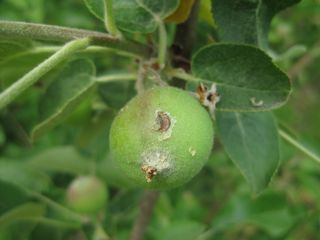 |
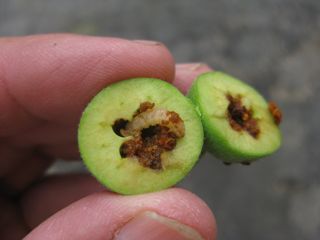 |
What is it? some kind of internal worm (Oriental fruit moth, codling moth, lesser apple worm, other?) feeding on apple fruit What does it mean? good question! After a relatively quiet summer last year for lepidopteran 'worms,' I expect a resurgence this year. You should be deploying pheromone traps and determining the need to spray based on biofix, orchard history, or consultant recommendation. lack of insecticide sprays in the next few weeks may mean some unwanted surprises later in the season or at harvest. See codling moth and obliquebanded leafroller trap catches below. |
What is it? obliquebanded leafroller (OBLR) in pheromone trap What does it mean? actual biofix date (1st trap catch) app. May 24. According to NEWA: Peak moth flight, first egg hatch. First hatch of summer OBLR eggs. Adult catches in pheromone traps are near peak numbers. In order to verify model predictions, monitor growing terminals to check for the detection of the first summer larvae. It is too early to monitor populations of summer larvae at this time to determine if control sprays are necessary because most eggs will hatch later during the summer. However, applying protective sprays with the first spray timed to coincide with the first hatch of larvae followed by a second spray 10-14 days later are recommended in orchards that have had a past history of severe OBLR fruit damage or if populations of overwintering larvae were high. |
|
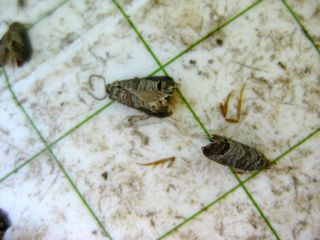 |
What is it? codling moth (CM) in pheromone trap What does it mean? estimated biofix date (1st trap catch) app. May 15. According to NEWA: Moth flight peaks and majority of eggs hatch. Adult flights are relatively heavy during this period and the majority of eggs are likely to hatch, so control is critical at this time. Apply a second spray 10-14 days after the initial spray that was timed at first hatch, to provide protection during this critical time period. In high-pressure orchards, it may be particularly important to apply other classes of materials to replace organophosphates or synthetic pyrethroids. |
What is it? bacterial canker on 'Chelan' cv. sweet cherry What does it mean? the early spring seems to have predisposed sweet cherry to bacterial canker infection. Not much can do now except prune-out canker strikes where feasible. Fall and spring applications of copper will help keep canker at bay, or, plant resistant (vs. susceptible) varieties. |
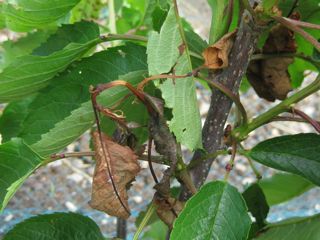 |
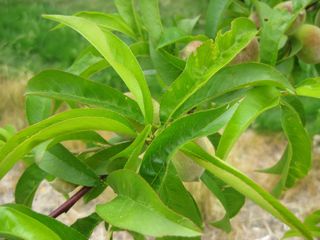 |
What is it? nitrogen deficiency on peach foliage What does it mean? you should have given peaches a good shot of nitrogen fertilizer by now. If not, your foliage will look yellowish, may have some holes, and overall the tree will look non-vigorous. Peaches should have dark green, large leaves now, with actively growing shoots. It is not too late to apply 1st or another nitrogen application now. As a rule of thumb, apply 0.05 pounds actual N per year of tree age in a split applictaion -- the first sometime pre-bloom and the second 2-3 weeks after shuck split. Young trees (1st and 2nd leaf) need 0.1 pound actual N per year of tree age. |
What is it? bird-eaten sweet cherries What does it mean? time to put up the netting. Cherries are about 10 days early ripening compared to 'normal.' |
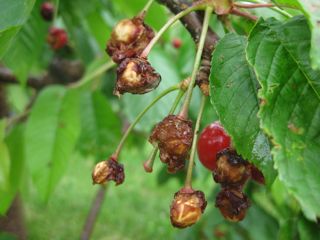 |
Useful links
UMass Fruit Advisor http://www.umass.edu/fruitadvisor/
UMass Cold Spring Orchard Weather Data http://www.umass.edu/fruitadvisor/hrcweather/index.html
Scaffolds Fruit Journal http://www.nysaes.cornell.edu/ent/scafolds/
NEWA (Network for Environmental and Weather Applications)
Orchard Radar for Belchertown, MA http://pronewengland.org/AllModels/MAmodel/RADARMA-Belchertown.htm
JMCEXTMAN Blog http://jmcextman.blogspot.com/
Follow me on Twitter http://twitter.com/jmcextman and Facebook http://www.facebook.com/jmcextman

